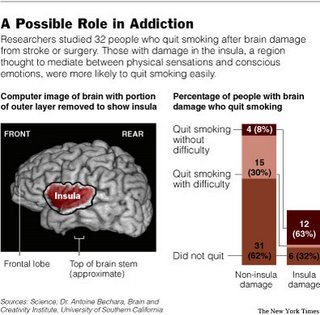Introducing: The Insula
 The image to the left comes from an article in today's NY Times, "In Clue to Addiction, Brain Injury Halts Smoking." But whether you're interested in quitting smoking or not, the real story here seems to be the powerful role of a region of the brain called The Insula, about which I have so far heard little to nothing. As for the smoking study, researchers have been taken by surprise to see that an addiction like smoking can be wiped out by an injury to a single, small area of the brain, since they also know there is "a whole neural circuit critical to maintaining addiction." Eliminating this one region, though, seems to get rid of the bodily craving underlying the urge to smoke. The insula has already been studied by Antonio Damasio (I'm a fan of his work, including the book The Feeling of What Happens). In an interview for the article, Damasio says the insula is "a critical platform for emotions": "“It is on this platform that we first anticipate pain and pleasure, not just smoking but eating chocolate, drinking a glass of wine, all of it.” As the article goes on to say "This explains why cravings are so physical, and so hard to shake...they have taken hold in the visceral reaches of the body well before they are even conscious. " Earlier studies of addiction had looked at regions of the brain involved in thinking and decision-making, but this study seems to get closer to the bodily, unconscious root of the matter. The insula has connections to both the thinking cortex above and to "subcortical areas, like the brain stem, that maintain heart rate, blood pressure and body temperature, the body’s primal survival systems." Damasio thinks the insula maps these kinds of subcortical signals "so the conscious brain can interpret them as a coherent emotion"(and I guess the "emotion" in this case is the experience of pleasure associated with smoking, though the article doesn't quite say). Anyway, I'm always interested in the ways that emotion arises from the body, and after that, the ways that emotions get tangled up with what we call "thinking." It looks like understanding the insula will give us another piece of the puzzle.
The image to the left comes from an article in today's NY Times, "In Clue to Addiction, Brain Injury Halts Smoking." But whether you're interested in quitting smoking or not, the real story here seems to be the powerful role of a region of the brain called The Insula, about which I have so far heard little to nothing. As for the smoking study, researchers have been taken by surprise to see that an addiction like smoking can be wiped out by an injury to a single, small area of the brain, since they also know there is "a whole neural circuit critical to maintaining addiction." Eliminating this one region, though, seems to get rid of the bodily craving underlying the urge to smoke. The insula has already been studied by Antonio Damasio (I'm a fan of his work, including the book The Feeling of What Happens). In an interview for the article, Damasio says the insula is "a critical platform for emotions": "“It is on this platform that we first anticipate pain and pleasure, not just smoking but eating chocolate, drinking a glass of wine, all of it.” As the article goes on to say "This explains why cravings are so physical, and so hard to shake...they have taken hold in the visceral reaches of the body well before they are even conscious. " Earlier studies of addiction had looked at regions of the brain involved in thinking and decision-making, but this study seems to get closer to the bodily, unconscious root of the matter. The insula has connections to both the thinking cortex above and to "subcortical areas, like the brain stem, that maintain heart rate, blood pressure and body temperature, the body’s primal survival systems." Damasio thinks the insula maps these kinds of subcortical signals "so the conscious brain can interpret them as a coherent emotion"(and I guess the "emotion" in this case is the experience of pleasure associated with smoking, though the article doesn't quite say). Anyway, I'm always interested in the ways that emotion arises from the body, and after that, the ways that emotions get tangled up with what we call "thinking." It looks like understanding the insula will give us another piece of the puzzle.In a further bit of conjecture the article wonders if people looking at MRIs of their own brain can be taught to deactivate the insula, thus reducing their cravings (in another study, people have been able to reduce the sensation of pain by looking at an MRI and modulating neural activity in a cortical region dealing with pain). How long, I wonder, before we have some sort of portable brain-monitoring unit that allows us to become expert at neural self-modulation? This sort of thing has been dreamed about, and even marketed, since as far back as the '80's, when we began to learn about "alpha waves." So far nothing has caught on, but I predict we'll get there in the not too distant future.

0 Comments:
Post a Comment
<< Home